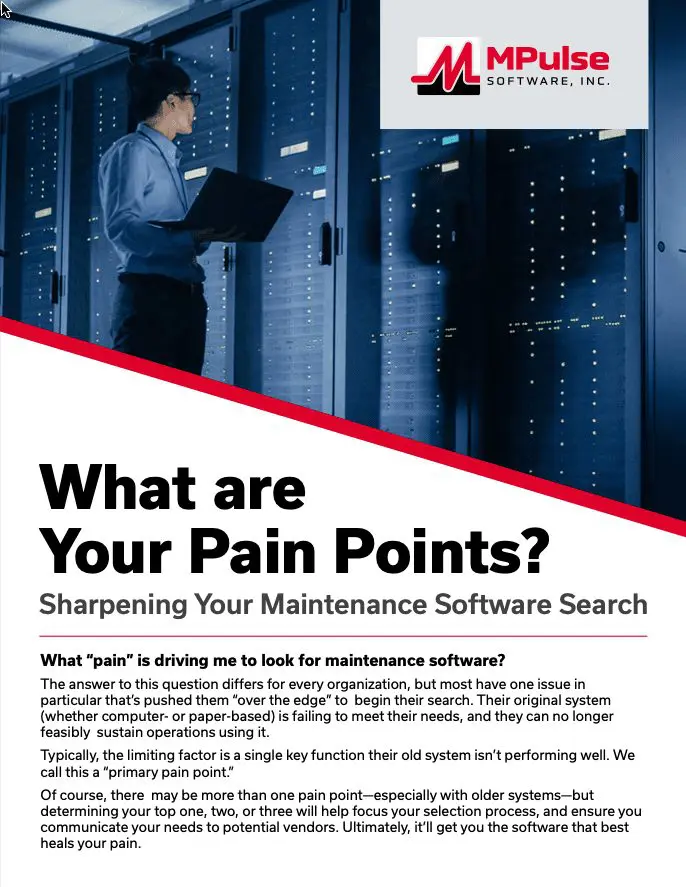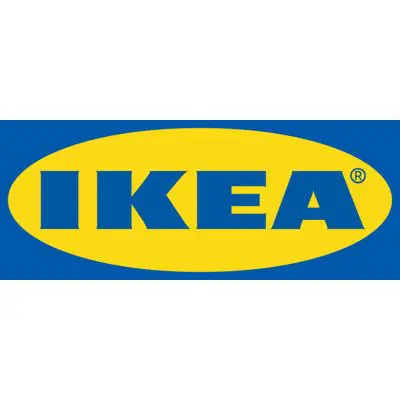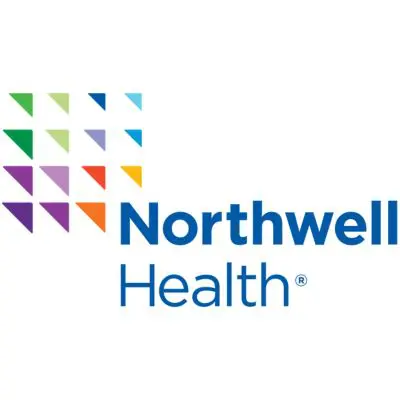Sharpening Your Maintenance Software Search
What “pain” is driving me to look for maintenance software?
The answer to this question differs for every organization, but most have one issue in particular that’s pushed them “over the edge” to begin their search. Their original system (whether computer- or paper-based) is failing to meet their needs, and they can no longer feasibly sustain operations using it.
Typically, the limiting factor is a single key function their old system isn’t performing well. We call this a “primary pain point.”
Of course, there may be more than one pain point—especially with older systems—but determining your top one, two, or three will help focus your selection process, and ensure you communicate your needs to potential vendors. Ultimately, it’ll get you the software that best heals your pain.
The Four Categories of Pain Points
Pain points tend to fall into 4 categories: Functional, Technological, Organizational, and Scalability.
Functional: A functional pain point occurs when an existing system isn’t delivering on a core maintenance-related function. It could be work order management or preventive maintenance (PM) scheduling. It might be vendor management, detailed reporting, or inventory control. Sometimes it’s service request management and tracking. Whatever it is, the existing system isn’t doing it well.
Often, we see this when organizations try to use other computer applications to perform the work of a CMMS/EAM solution. It’s like trying to drive a nail with a screwdriver. You might be able to do it, but the right tool would make the job a lot easier.
If your primary pain point is functional, you probably recognize it already. It impacts your job every day and impedes your ability to perform or track basic maintenance functions.
Technological: A technological pain point occurs when the system you’re currently using is no longer a match for the way you need to conduct the management, execution, and tracking of maintenance. The shoe no longer fits, as it were. As Internet technologies continue their rapid advance, so too do the expectations of senior management teams in organizations everywhere. The pace of business often seems to be forging ahead without consideration for the time it takes us to maintain the critical infrastructure that drives it.
You may find you’re being asked to…
- Provide key reports in near real time.
- Know immediately when key equipment is down or underperforming.
- Monitor vital conditions on major assets and predict failures.
- Manage ever-larger numbers of assets with fewer and fewer resources.
- Provide access to maintenance management information for a broader set of stakeholders, sometimes across multiple locations—or even on smartphones or tablet devices like the iPad.
- Field service and repair requests from hundreds or thousands of requesters, and provide status updates in real time.
Clearly, you’ll never be able to satisfy these requests with paper-based systems. And homegrown systems based on Excel spreadsheets or Access databases just won’t cut it. Even earlier-generation CMMS and EAM applications fall far short of most contemporary requirements.
Fortunately, modern maintenance management software is keeping up with the pace of change. Do you need real-time work order updates from your technicians with smartphones in the field? Do you need detailed, easily customizable reports for your boss? Do you need to extend maintenance software access to a team spread across the state—or across the globe?
These are all perfectly reasonable—and easily attainable—goals. Give some thought to what your technological pain points are, and do your best to clearly articulate them to potential vendors. Leading CMMS/EAM vendors should easily be able to meet your requirements.
Organizational: Sometimes a pain point isn’t driven by a need that’s readily apparent to the maintenance manager. The need or expectation originates elsewhere in the organization, but the fulfillment of that need falls to the maintenance manager—and his maintenance management software. Organizational pain points aren’t defined in the traditional sense as causing direct pain. Instead, organizational pain “rolls downhill” to you from elsewhere in the company.
Organizational pain points may be driven by a corporate merger or acquisition. They may arise from new regulations or compliance requirements. They may result from a corporate “reorg,” or the hiring of a new senior manager. Regardless of where they come from, you’re likely to learn about them from your boss. Typically, they come down as a mandate: “Find me new maintenance software that meets these requirements.”
When you’re able to recognize an organizational pain point, do your best to learn what’s driving your boss’s request. Probe a bit and see if you can uncover the source of the requirements. The more you understand about the real pain point, the better you’ll be able to communicate it to potential vendors—and the better you’ll be able to heal your boss’s pain.
Scalability: Scalability is the capacity to grow as an organization grows. It’s typically tied to organizational and technological changes. Maybe changes in an organization are driving growth in business and employee headcount. Maybe better network connections are increasing the ability of a company to work across multiple geographies. Maybe an expanded facilities footprint is drastically increasing the number of service requests.
A scalability pain point occurs when your existing systems aren’t able to adapt to the increased scale of the operation. You might be tempted to argue that a scalability pain point is the same as an organizational or technological one. To some extent, you’d be right.
However, if growth in the number of locations, employees, or service requesters is the key driver of your pain, it’s important to call that out. It’ll help potential software vendors understand your situation better and provide alternatives better suited to your rapidly expanding operation.
Capture Your Pain—and Use It!
Before you begin talking to maintenance software vendors, capture your pain on paper. Brainstorm a list of your top three pain points in clear and concise bullets. You might start by writing down as many as you can think of. Then do your best to whittle the longer list down to no more than three. Focus is key. While your broader list of requirements is important, if you don’t fix what’s causing you the most pain, the rest will never matter.
Once you’ve bulleted out your top three pain points, you’ll be able to articulate clearly to vendors the functions and features important to you. The exercise of documenting and naming your pain points will focus your discussion with sales reps and get you the information most relevant to your needs. You’ll be able to draw meaningful comparisons between vendors on the software capabilities that matter most for your organization—and you’ll choose the solution that does the best job of healing your pain.








